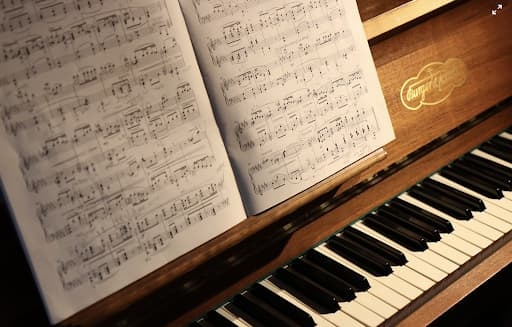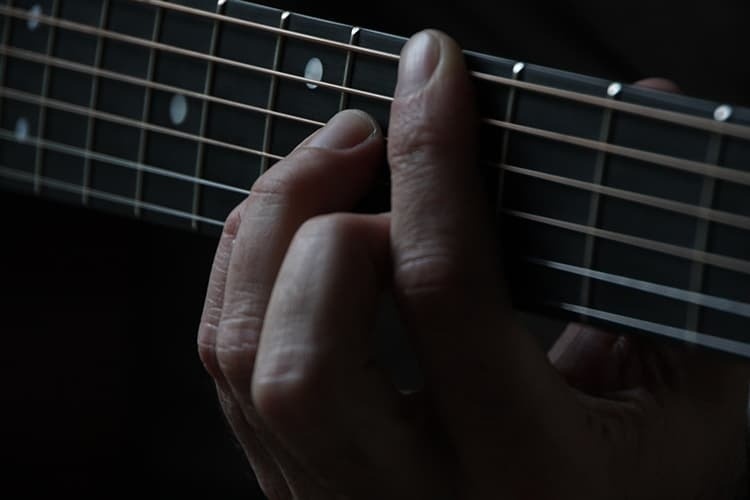Melody Ear Training: Recognizing musical melodies
One skill that all musicians need to develop is the ability to recognize melodies by ear. Melody ear training allows you to foster this invaluable skill and take your musicality to the next level.
While melodic ear training can be challenging at first, it is an essential skill that will help you become a better musician overall. We'll show you how to make your melody ear training journey fun and easy thanks to our science-based, step-by-step ear training method.

What is a melody?
A melody is a series of musical notes played in sequence. Melodies have a distinct character and an underlying logical structure. These two elements strive to communicate a specific feeling and a musical message.
In addition, melodies are the foreground of musical pieces and songs, therefore they are characterized by a singable and memorable quality. As listeners, we connect with the melody first and we remember the melody of a song before anything else.
Importance of melody recognition ear training
As the name suggests, melody recognition ear training is a specific area of study that focuses on the ability to identify melodies by ear without the help of a musical instrument.
By practicing and fostering this valuable skill, you will be able to strengthen your short-term musical memory, which plays a very important role in the recognition of melodies by ear.
In addition, melody ear training allows you to improve your inner sense of pitch. This is particularly helpful for all musicians that are striving to learn songs by ear and readily play original musical ideas on an instrument.
Lastly, recognizing melodies by ear can help you make better choices intuitively both when you are improvising and when you are composing your own music.


How to recognize melodies
An important premise is needed at this point: with the term melodies we are referring to “musical melodies” rather than “random sequences of notes”. Actual melodies sound “musical” to us because they are built around a tonality (“musical key” or “musical scale”) and therefore display an underlying coherence and a sense of direction. On the contrary, if we put together a series of random notes, they will lack structure and logic and will sound like a collection of unrelated pitches with no musicality.
Before you can understand how to recognize melodies, you have to always take into account that every melody includes notes that belong to a specific key or scale. Melodies that are built with notes from multiple keys/scales exist as well but are much more complex to figure out. At first, it is best to start simple and only work with melodies that consist of the notes from a single key/scale.
When learning how to recognize melodies, you should focus mainly on developing the ability to identify the scale degree of each note that makes up the melody. There are different mechanisms for recognizing notes and melodies. Each one of them is based on internalizing and recognizing the sensation of rest or tension that each note assumes within the context of the key in which the melody is played.
The three main mechanisms are:
- 1st mechanism: recognizing the key's color of the note.
- 2nd mechanism: recognizing the note by thinking of the scale.
- 3rd mechanism: recognizing multiple notes at the same time by referring to higher-order familiar patterns.
Let’s have a closer look at each of the three mechanisms.

1) Recognizing the key's color of the note
The first mechanism for recognizing melodies is to identify the key's color of the note. This term refers to the unique feeling or sonic ‘sensation’ that the note assumes within the musical key. If this concept isn’t clear to you, please check out this video where we explain it in much more detail. Each scale degree has a specific character or “key’s color”, which gives individuality and discernibility.
To master this technique, the first step is identifying the tonic note of the key in which the melody is played. Once you have done so, you proceed to single out the scale degree of each note in the melody by recognizing their key’s colors. What you are looking for is to perceive the level of tension or rest/resolution of each note in relation to the tonic note.
Let’s take the key of C major as an example. Within this tonality, the note C creates a sensation of rest because that is the keys’ color of the tonic within the major scale. On the contrary, the note B creates a sensation of tension (that’s the keys’ color of the 7th degree of the major scale) and causes the expectation of resolving back to C (the tonic note). All other notes convey different and unique sensations based on the scale degree they represent.
Once you are properly trained, recognizing notes using the first mechanism is intuitive, quick and effortless. It becomes as easy as telling visual colors apart. Distinguishing red from blue is something you can do without thinking, can’t you? That’s how great musicians recognize melody by ear on the fly. The Use Your Ear method teaches musicians how to get there, by developing the first mechanism (along with many other important skills) in a gradual, step-by-step approach.
2) Recognizing the note by thinking of the scale
The second mechanism for recognizing melodies is to determine the scale degree of each note by relating them to the scale they are built from. To do this, you must first learn how to identify the key/scale in which the melody is played. Once you have determined the scale in which the melody is played, use your voice to match the notes in the melody to specific degrees of the scale. When doing that, you can sing the notes out loud or in your head.
3) Recognizing multiple notes at the same time by referring to higher-order familiar patterns
The third mechanism for recognizing melodies is to identify multiple notes simultaneously by associating them to higher-order familiar patterns. These patterns can be scales, arpeggios, or even portions of melodies you already know and therefore are really familiar to you.
For example, if you hear a melody including the following scale degrees - 2,3,4,5,3,2,1 - you can easily recognize that there are two separate portions of a scale there. The first part is an ascending portion of the scale (2,3,4,5) while the second is a descending fragment of the scale (3,2,1).
Melody Ear Training: Wrong Approaches
There are a couple of ineffective approaches for melody ear training which, unfortunately, are used by a lot of musicians who don’t know how our perception of musical pitch works from a scientific point of view. Musicians who follow these approaches almost always end up in frustration and despair, without seeing a real improvement from their efforts and commitment. These counterproductive methods are “interval ear training” and “the trial and error approach”.


Issues related to the interval ear training method
When following the interval ear training method, musicians are asked to identify the intervals between two notes. Unfortunately, this strategy is an unnecessarily difficult task and does not allow you to quickly and effortlessly recognize melody by ear. In other words, this is not how great musicians intuitively figure out melodies by ear.
The main issue with the interval method is that it doesn't take into account that our perception of musical pitch is context-dependent. As a consequence, it inadvertently asks students to perform very difficult exercises from the very beginning of their learning stages. For most students this is like trying to run before learning how to walk. This is why they make little to no improvement by practicing interval-based exercises.
There are many other issues related to the interval ear training method, check out this video if you want to know why you are stuck and not making progress with interval-based exercises.
Issues related to the trial and error method
The trial and error method is another common counterproductive approach to melody ear training. In this approach, musicians try to identify a melody by playing random notes on their instrument until they find the notes that match the ones played in the melody.
This is a very inefficient way to recognize melodies because it doesn’t allow musicians to develop the ability to figure out melodies by ear mentally (without the help of any musical instruments). As a consequence, musicians who follow this approach are not going to develop their inner sense of pitch and their musicality will remain stagnant and underdeveloped. This is simply because they are “cheating” by helping themselves with an instrument.
Approaching melody ear training following an interval based method or a trial and error approach will always require a lot of rational effort. Whereas, as a musician, you should always aim to identify notes and melodies intuitively, with as little conscious/rational effort as possible, as great musicians do.


Melody ear training exercises
Although there is a lot of free content available nowadays, most exercises you will encounter fail to follow a logical step-by-step path that reflects how melodic recognition skills naturally work and develop. Most importantly, they do not offer a system that is based on tonality, which is scientifically proven to be the most effective.
The best way to improve your ability to recognize melody is to work with a method that takes into consideration all of the elements and mechanisms we highlighted so far and aims at increasing your skills in a gradual and coherent way.
Rather than following untested and random exercises that are not going to help you develop your ear, we advise you to work within a system that is strongly rooted in the context of tonality. The following melodic ear training exercise will help you develop your ability to identify melodies more efficiently.
Melodic dictation
Ear training and melodic dictation are two sides of the same coin. Melodic dictation is one of the most effective ways to strengthen your ear training skills and improve your ability to recognize a melody. Through dictation exercises you will be able to also expand your short term musical memory and note-retention skills in a gradual and successful way.
Practicing dictation with a tonality-based approach is by far the most effective method available. All our ear training and melodic dictation exercises are structured by providing the student with a drone chord, which consists of the Tonic, 5th, and the Tonic again (down an octave from the fundamental note).
By hearing the underlying and continuous sound of the drone, the student is able to remain grounded in the tonality and the recognition of different scale degrees becomes much easier. Thanks to our progressive methodology, students are able to quickly improve their abilities and retain longer melodies over a short period of time.


Short-term musical memory
Melodic dictation ear training will strengthen your short-term musical memory, which is one of the most powerful faculties that is worth enhancing.
Short term musical memory is one of the two key elements in the melodic recognition system. The mental process of identifying the notes of a melody requires us to firstly retain those pitches in our short term memory before we actually proceed to analyze them.
Many scientific studies, including “immediate Recall of Melodies’ by Sloboda and Parker, have shown that our perception of musical pitch is strongly dependent on our ability to figure out the underlying harmonic framework that is implied by the melody itself. This means that having a solid understanding and internalization of the tonality is essential to properly retain notes and recognize melodies by ear.
The more we train ourselves to hear all the music vocabulary contained within the tonal framework, the more we will easily retain the notes we are hearing in a given melody. Moreover, immersing ourselves in the context of tonality will allow us to make an emotional connection with the feeling or the sensation of the notes within the scale or key so that identifying them will be very intuitive and easy.
Want to learn to recognize melodies by ear? We can help you
If you feel stuck and are unable to systematically make progress in your ear training journey, the Use Your Ear method can help you reach your musical goals.
You will have access to scientific-based methods that offer a progressive development and a systematic approach. You will focus on developing one sub-skill at a time and work at a level of difficulty that matches your current abilities, thus avoiding frustration and the feeling of being overwhelmed.
Our program will gradually allow you to internalize powerful cognitive processes that will make the recognition of melodies, chords and other musical elements more intuitive and straightforward.


Relative Pitch Video-Course
If you are serious about taking your ear training skills to a whole new level, our relative pitch course is perfect for you. You will gain insight into our ground-breaking model which has been designed by taking scientific-based knowledge as a core foundation and then by testing different exercises and ear training strategies on hundreds of real students for years.
Thanks to the experience we’ve gained through this long process, our carefully organized and step-by-step 14 units of study will allow you to develop all the sub-skills that are required to become highly proficient in ear training. Some of the specific sub-skills we focus on are pitch matching, tonic retention, tonic recognition, melodic recognition, short-term musical memory, chord recognition, and many more.
The Use Your Ear video course is available nowFree Use Your Ear Workshop
At Use Your Ear, we have put together a free workshop for everyone to get a sample and an overview of the program we carefully designed. The 3-hour long free workshop is packed with tons of material that is based on scientific research and is guaranteed to offer tangible results.
You will have access to exercises and strategies that will show you practical ways to get better as well as detailed discussions on the ineffective strategies you should avoid.
You will be able to hear the testimonials of many students that have benefitted from our innovative program and you will have access to two unique gifts we have prepared for you. Make sure to register to our free workshop and take advantage of these amazing opportunities.
Free online ear training workshop

Individual online lessons
One of the best ways to improve your ear is to work with an experienced teacher that can offer you guidance and expertise. Individual online lessons are a great way to have an assessment of what level of skills you are currently at and to put into place an effective strategy that will lead you to reaching the goals you have set for yourself. We have taught hundreds of students over the years and we would love to help you in your musical journey.
One-on-one ear training lessons onlineHow our students learn to recognize melodies by ear in just a few months
Check out how our students go from zero to recognizing melodies by ear in a few months, following the Use Your Ear method.
Who are our courses for?

For both beginner and seasoned musicians who want to develop their relative pitch skills.

For musicians or music students who are struggling with melodic ear training, chord progressions ear training, etc.

For anyone who has already tried other ear training methods without success. Our innovative science-based method is designed to work for you.





